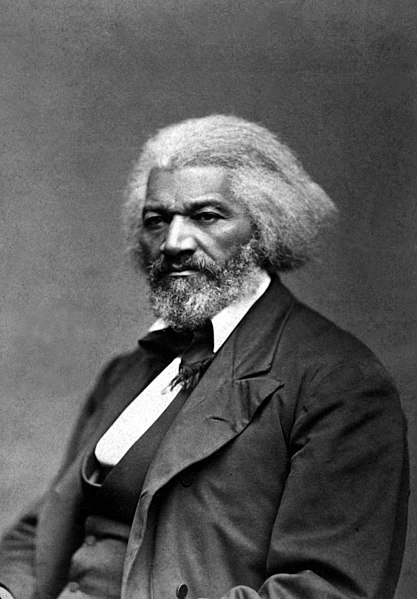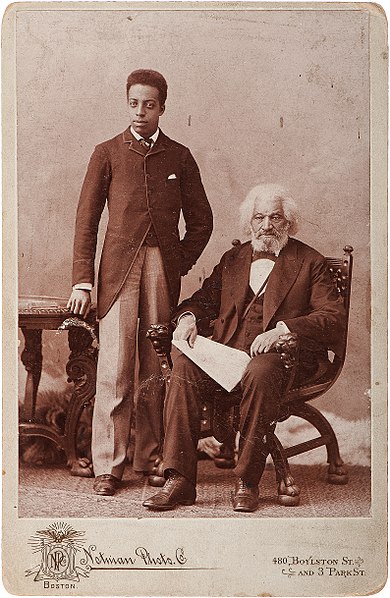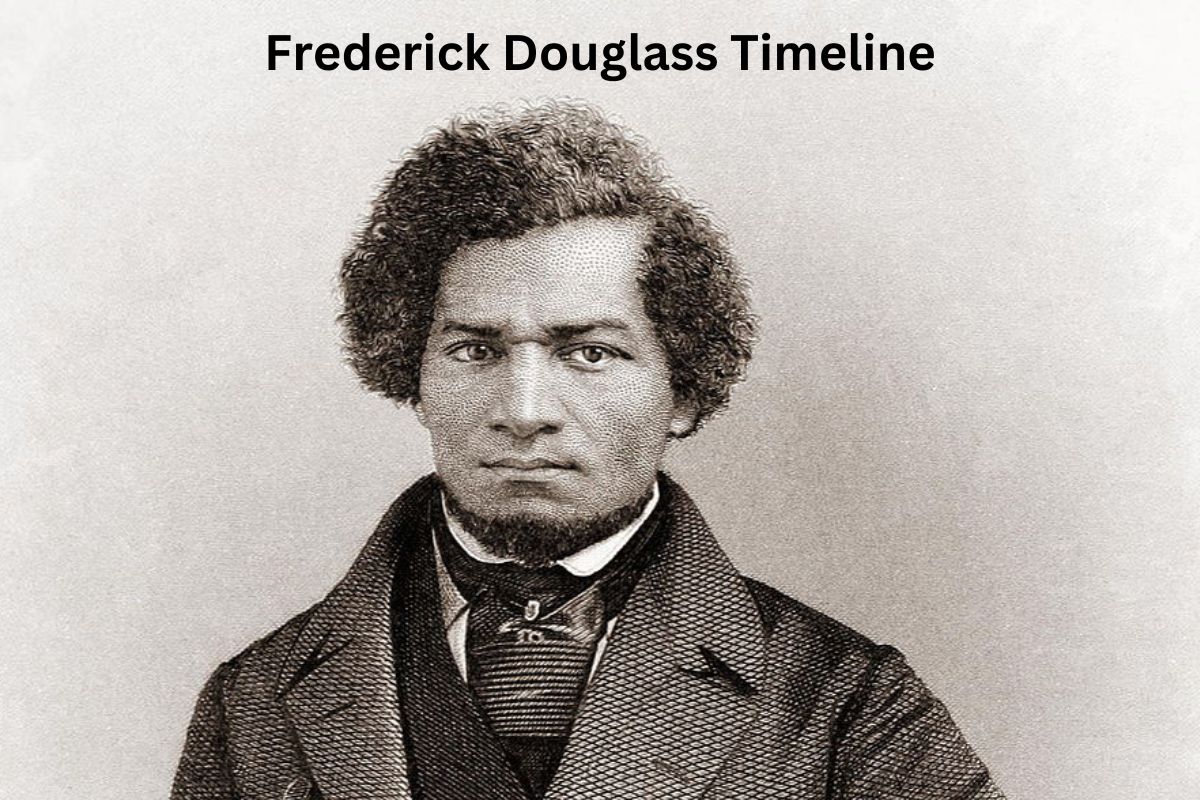Frederick Douglass was a towering figure in 19th-century America, known for his remarkable journey from slavery to become a prominent abolitionist, writer, orator, and statesman.
Born into bondage, Douglass’s thirst for knowledge, eloquence, and unwavering commitment to the cause of freedom made him a leading voice in the fight against slavery and an advocate for civil rights.
His life’s work included escaping slavery, delivering powerful speeches, publishing influential autobiographies, and holding significant government positions.
Douglass’s legacy continues to inspire generations as an emblem of resilience, activism, and the relentless pursuit of justice and equality.
| Year | Event |
|---|---|
| c. February 1818 | Frederick Douglass is born into slavery in Tuckahoe, Maryland. |
| 1826 | Douglass is separated from his mother and sent to live with the Auld family in Baltimore, Maryland. |
| 1838 | Douglass escapes from slavery in Baltimore, Maryland, and settles in New Bedford, Massachusetts. |
| 1841 | Douglass becomes a prominent abolitionist speaker after speaking at an antislavery convention. |
| 1845 | Frederick Douglass publishes his first autobiography, “Narrative of the Life of Frederick Douglass, an American Slave.” |
| 1847 | Douglass starts publishing the abolitionist newspaper “The North Star.” |
| 1852 | Douglass delivers his famous speech, “What to the Slave Is the Fourth of July?” |
| 1861-1865 | During the Civil War, Douglass advocates for African American enlistment in the Union Army. |
| 1865 | The Thirteenth Amendment to the United States Constitution, abolishing slavery, is ratified. |
| 1870 | Douglass becomes the editor of “The New National Era” and serves as the President of the Freedman’s Savings Bank. |
| 1872 | Nominated for Vice President of the United States as a candidate of the Equal Rights Party. |
| 1877 | Appointed as United States Marshal for the District of Columbia. |
| 1881 | Appointed as Recorder of Deeds for the District of Columbia. |
| 1889 | Publishes his third autobiography, “Life and Times of Frederick Douglass.” |
| 1895 | Frederick Douglass passes away in Washington, D.C., on February 20. |
Timeline of Frederick Douglass
c. February 1818: Frederick Douglass is born into slavery in Tuckahoe, Maryland.
Frederick Douglass, originally named Frederick Augustus Washington Bailey, was born into slavery on a plantation in Tuckahoe, near the town of Easton, Maryland. His exact birth date is not known, but it is believed to be around February 1818.
He was born to Harriet Bailey, a slave, and the identity of his father is uncertain. From his earliest days, Douglass experienced the harsh realities of slavery, witnessing the cruelty and brutality that enslaved people endured in the American South.

1826: Douglass is separated from his mother and sent to live with the Auld family in Baltimore, Maryland.
In 1826, when Frederick Douglass was just a young child, he was separated from his mother, Harriet Bailey, as a common practice of the slave trade. He was sent to live with the Auld family in Baltimore, Maryland.
It was here that he began to learn to read and write from Sophia Auld, the wife of his owner, Hugh Auld. This initial exposure to education was a pivotal moment in his life, as it ignited his desire for knowledge and laid the foundation for his future as an influential writer and orator.
Sophia Auld’s initial willingness to teach him soon ended under pressure from her husband and others who believed that education would make a slave rebellious.
1838: Douglass escapes from slavery in Baltimore, Maryland, and settles in New Bedford, Massachusetts.
In 1838, when he was approximately 20 years old, Frederick Douglass decided to take a daring step towards freedom. He managed to escape slavery in Baltimore, Maryland, by using borrowed identification papers and disguising himself as a sailor.
This escape was a dangerous and daring act, but it marked a turning point in his life. He made his way to New Bedford, Massachusetts, where he found relative safety and freedom. It was in New Bedford that he adopted the name “Frederick Douglass” as his chosen identity.
This marked the beginning of his journey as a prominent abolitionist, writer, and speaker who would dedicate his life to advocating for the abolition of slavery and the rights of African Americans in the United States.
1841: Douglass becomes a prominent abolitionist speaker after speaking at an antislavery convention.
In 1841, Frederick Douglass attended an antislavery convention on Nantucket Island, Massachusetts. At this convention, he was asked to share his experiences as a former slave. His speech was so powerful and moving that it launched his career as a prominent abolitionist speaker.
Douglass’s ability to articulate the brutalities of slavery, the dehumanization of enslaved people, and his personal journey to freedom captivated audiences. He was soon recognized as one of the most compelling and eloquent voices in the abolitionist movement.
This event marked the beginning of his role as a tireless advocate for the abolition of slavery and equal rights for all.

1845: Frederick Douglass publishes his first autobiography, “Narrative of the Life of Frederick Douglass, an American Slave.”
In 1845, Frederick Douglass published his groundbreaking autobiography, “Narrative of the Life of Frederick Douglass, an American Slave.”
This book provided a vivid and firsthand account of the horrors of slavery, as well as Douglass’s personal journey from enslavement to freedom. It became a bestseller and a powerful tool in the abolitionist movement, helping to sway public opinion against slavery.
The book also served as a testament to the importance of education and literacy in the fight for liberation, as Douglass had learned to read and write despite the oppressive conditions of slavery.
1847: Douglass starts publishing the abolitionist newspaper “The North Star.”
In 1847, Frederick Douglass launched his own antislavery newspaper called “The North Star.” The newspaper was published in Rochester, New York, and became one of the most influential abolitionist publications in the United States.
Douglass used the newspaper as a platform to advocate for the immediate abolition of slavery, civil rights for African Americans, and other social and political causes. He served as the editor of the paper and wrote many of its articles and editorials.
“The North Star” was instrumental in spreading the abolitionist message and rallying support for the cause of freedom.
1852: Douglass delivers his famous speech, “What to the Slave Is the Fourth of July?”
In 1852, Frederick Douglass delivered one of his most famous speeches, “What to the Slave Is the Fourth of July?” The speech was given in Rochester, New York, to a predominantly white audience on July 5th, and it remains a powerful and poignant critique of American hypocrisy.
In the speech, Douglass eloquently questioned the celebration of American freedom and independence while millions of African Americans remained enslaved. He pointed out the stark contrast between the ideals of liberty and the reality of slavery in the United States.
The speech served as a powerful call to action and highlighted the moral urgency of the abolitionist cause.

1861-1865: During the Civil War, Douglass advocates for African American enlistment in the Union Army.
When the American Civil War broke out in 1861, Frederick Douglass saw it as an opportunity to advance the cause of freedom and equality for African Americans. He became a vocal advocate for the recruitment of African American soldiers into the Union Army.
Douglass believed that their service in the war would not only contribute to the Union’s victory but also earn them the right to full citizenship and equal rights. His efforts played a significant role in the eventual enlistment of over 180,000 African American troops in the Union Army.
1865: The Thirteenth Amendment to the United States Constitution, abolishing slavery, is ratified.
In 1865, the Thirteenth Amendment to the United States Constitution was ratified, officially abolishing slavery throughout the United States.
This historic amendment marked a monumental achievement in the fight against slavery and was a significant step towards the realization of Frederick Douglass’s lifelong goal.
Douglass had worked tirelessly to advance the abolitionist cause, and the ratification of the Thirteenth Amendment was a momentous victory.
1870: Douglass becomes the editor of “The New National Era” and serves as the President of the Freedman’s Savings Bank.
In 1870, Frederick Douglass took on two important roles in Washington, D.C. He became the editor of “The New National Era,” a newspaper dedicated to African American rights and issues.
Simultaneously, he was appointed as the President of the Freedman’s Savings Bank, an institution established to help newly freed African Americans save money and gain financial independence.
In these positions, Douglass continued to advocate for civil rights and economic empowerment for African Americans during the challenging post-Civil War Reconstruction era.
1872: Douglass is nominated for Vice President of the United States as a candidate of the Equal Rights Party.
In 1872, Frederick Douglass made history by being nominated as the Vice Presidential candidate of the Equal Rights Party during the presidential election. The party was a third-party ticket that advocated for the rights of African Americans and women.
While the campaign was not successful, Douglass’s nomination was a significant moment in American politics. It symbolized his prominence as a leader in the civil rights movement and his commitment to political activism.
1877: Appointed as United States Marshal for the District of Columbia.
In 1877, President Rutherford B. Hayes appointed Frederick Douglass as the United States Marshal for the District of Columbia. This appointment made him the first African American to hold such a high-ranking federal position.
In this role, Douglass was responsible for enforcing federal laws within the District of Columbia, and his appointment was seen as a recognition of his contributions to the nation and the advancement of civil rights.
1881: Appointed as Recorder of Deeds for the District of Columbia.
Frederick Douglass’s dedication to public service continued when he was appointed as the Recorder of Deeds for the District of Columbia in 1881.
In this position, he was responsible for recording and maintaining property records and other legal documents for the district. Once again, he was a trailblazer as the first African American to hold this position, and his work contributed to the ongoing struggle for equal rights.
1889: Publishes his third autobiography, “Life and Times of Frederick Douglass.”
In 1889, Frederick Douglass published his third autobiography, “Life and Times of Frederick Douglass.” This book provided further insights into his life, experiences, and his perspective on the historical events of his time.
It covered his escape from slavery, his years as an abolitionist, his political career, and his thoughts on the state of the nation after the Civil War. “Life and Times of Frederick Douglass” remains a valuable historical account of the 19th century and his own remarkable journey.
1895: Frederick Douglass passes away in Washington, D.C., on February 20.
Frederick Douglass passed away on February 20, 1895, in Washington, D.C. His death marked the end of a life dedicated to the pursuit of freedom, equality, and justice.
Douglass’s legacy as a leading abolitionist, writer, orator, statesman, and advocate for civil rights continues to inspire people around the world. His impact on American history and the ongoing struggle for civil rights remains profound, and his contributions are celebrated to this day.
